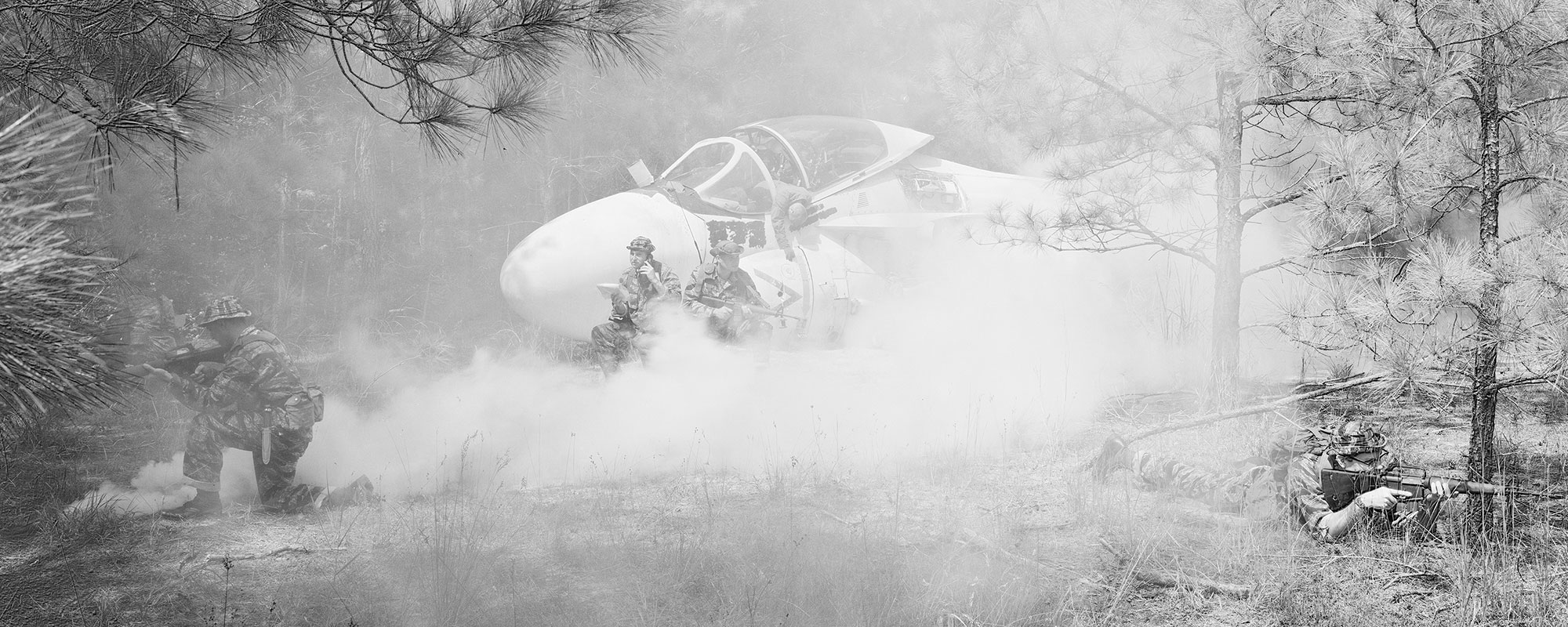Smoke pours from an airplane downed in a remote wilderness. The body of the pilot dangles from the cockpit. Two soldiers crouch by the hull; one barks into a satellite telephone, the second scans the trees for enemy snipers, gun ready. Other members of the unit fan out, taking up defensive positions.
This super sharp black-and-white photograph wasn’t snapped during the thick of battle. Instead it captures a group of Vietnam War reenactors in rural Virginia. When photographer and filmmaker An-My Lê made the image for her series Small Wars (1999–2002), she asked the men to pause mid-action so she could duck under the cloak of her wooden, bellows view camera. First manufactured in the 1920s, the five-by-seven Deardorff field camera requires time for setup and exposure.
“I’m not able to photograph in spontaneous ways, so I look for a different perspective,” Lê explains. She doesn’t view it as a liability. “Susan Sontag writes that the depiction of violence can be so painful that you have to look away. When I photograph a situation that’s not quite real, such as training, the viewer has more space to think about what they are looking at,” she adds, referencing Regarding the Pain of Others, Sontag’s book on representing war in art and photojournalism.
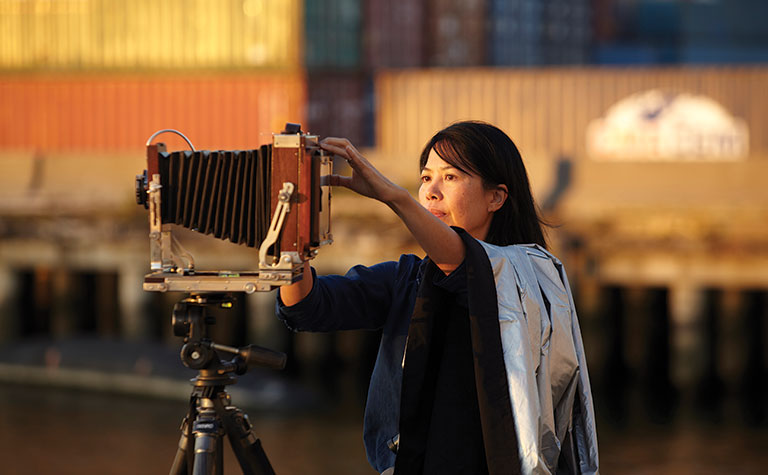
Portrait of An-My Lê, 2012 © John D. & Catherine T. MacArthur Foundation
“Her work is very oblique and subtle. These are photographs that ask more questions than they answer.” – Dan Leers, curator of photography at Carnegie Museum of Art
Born in 1960 in Saigon to two accomplished educators, Lê has spent most of her artistic career considering war and the military, but without photographing direct conflict. Instead, she produces work that reflects on the lingering effects of battle in Vietnam, captures life aboard aircraft carriers, and documents American soldiers around the world practicing for combat. “War is ever-present,” she says. “If there is not an active war we are trying to deal with the ghosts of the past or we are preparing for a future war.” Much of her work, like her series with the reenactors, considers how narratives of war are created and mediated—often through the flickering accuracy of personal recollections or contested in public memory—and how they impact the natural landscape.
It was this unique perspective that caught the eye of Dan Leers, curator of photography at Carnegie Museum of Art. “Her work is very oblique and subtle,” Leers says. “These are photographs that ask more questions than they answer.”
An-My Lê: On Contested Terrain, the artist’s first comprehensive survey, will include more than 110 works, starting with her photographs of ateliers in Paris from the early 1990s and ending with her current series focusing on the crisis at the Mexico-United States border and the American controversy surrounding Confederate monuments. On Contested Terrain will be on view in the Heinz Galleries March 14–July 26.
Quiet Authority
Lê was 8 years old when the North Vietnamese Army invaded Saigon, and she remembers walking to school only to find a smoldering gate where a bomb just fell. At 15, she was airlifted from the city along with her two brothers. “We feel very lucky that we were able to escape,” she says. Her family eventually settled in Sacramento, California.
In 1981, Lê was in her final semester of a master’s degree in biology at Stanford University and had already been accepted into medical school. She needed a non-science credit and happened into a photography class. Once she picked up the camera, her whole trajectory changed. “I always felt that there was work and then there was life, and life was so much more interesting. Suddenly I felt like everything could be connected,” she remembers. “The camera gave me license to go look at things I was curious about. It gave me a quiet authority.”
With the support of her mentor, Laura Volkerding, a photographer known for her stark images of American vernacular architecture, Lê abandoned medical school and instead studied photography in Yale University’s MFA program, working with a large-format camera. “Women photographers who used large format at that time tended to photograph their families. But Laura didn’t fit the mold,” Lê recalls. “Seeing her work with it made it seem possible for me.”
For her first major photographic series, Lê decided to return to Vietnam. “It had become an imaginary world,” she says. “I wanted to make it real, make it palpable.” Her choice of camera allows her to achieve that palpability because she can enlarge her negatives without losing detail. “I want the prints to be a certain size so that you can walk into the image,” she says.

An-My Lê, Sniper II from the series Small Wars, 1999–2002, gelatin silver print, 26.5 x 38 in. (67.3 x 96.5 cm); Courtesy the artist and Marian Goodman Gallery © 2020 An-My Lê
When it came time to hike through the wilderness with her bulky equipment for Small Wars, she took comfort in the fact that Civil War photographers like Timothy O’Sullivan and Mathew Brady were able to photograph battlefields with cameras even larger than hers. “If O’Sullivan could figure it out, I could, too,” says Lê. However, she was terrified at first, since she was one of the only women and the only person of Asian descent camping out on private land. In order to participate, she had to be in character as a Vietcong soldier. Wearing the North Vietnamese uniform felt “crazy,” she says. “I kept thinking, my God, if my dad saw me in the Vietcong uniform he’d pass out.”
“I am absolutely not a war photographer. I find it much more interesting and much more slippery to work with a side-glance view.” – An-My Lê
Despite her initial misgivings, she discovered a kind of kinship with the men she was working with. “They were like artists,” she recollects. “They had unanswered questions and were just as into complexity as I was.” During the experience, she witnessed how their ideas of the Vietnam War were informed by movies like Full Metal Jacket and Apocalypse Now, as well as by stories passed on from generation to generation. “What they were doing is symbolic of something much bigger,” she adds. “It’s about this myth of the war and how there has not been any closure.”
The Complexity of War
Lê gives visual cues that what we’re seeing is performance. Her willingness to engage with her subjects while withholding judgment is one of the reasons Leers wanted to bring her work to Pittsburgh, where there is a concentration of active and veteran military personnel and a significant Southeast Asian population.
Some of the programming around the exhibition will include veterans giving tours of the galleries and talking about their experience, as well as screenings of war movies and writing workshops with area literary organizations. “We anticipate difficult conversations and we don’t want to shy away from them,” Leers says. “This is a safe space where people can feel respected.”
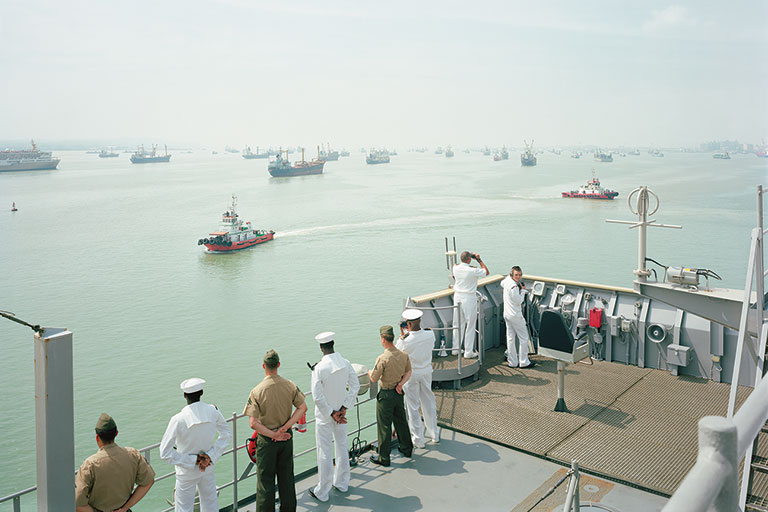

An-My Lê, Manning the Rail, USS Tortuga, Java Sea from the series Events Ashore, 2010; Portrait Studio, USS Ronald Reagan, North Arabian Gulf from the series Events Ashore, 2009, inkjet prints, 40 x 56.5 in. (101.6 x 143.5 cm) each; Courtesy the artist and Marian Goodman Gallery © 2020 An-My Lê
Leers is organizing Lê’s photographs thematically, bookended by a mix of early and newer work, where galleries of black-and-white images punctuate her color images. Lê’s first use of color was in 2006 with Events Ashore, a series about life aboard U.S. Navy vessels, which took her to 20 countries over nine years. Using color enabled Lê to better distinguish between ocean and sky. Some of the photographs in this series are taken from a distant, elevated viewpoint to show the scale of the Navy’s activities. But she also includes more intimate images, like an officer getting ready for his portrait session in a studio aboard the USS Ronald Reagan. He sits in front of two flags as a woman in uniform adjusts his collar.
“It’s such a great picture,” says Leers. “She captures these intimate moments of life that you never see unless you are on these vessels.” Lê is able to achieve such a remarkable level of access, in part, because her photographs are about understanding the complexity and scale of the military, not necessarily drawing conclusions or judgments. “Lê gives us the space to take a breath and try to see the world from someone else’s perspective,” says Leers.
That’s not to say Lê, whose work is included in many major museum collections, is reaching for the objectivity of a photojournalist. Instead, each information-rich image is highly considered. Sometimes she asks people to move or redo something, which would be unthinkable for a photojournalist. “I am absolutely not a war photographer,” Lê says. “I find it much more interesting and much more slippery to work with a side-glance view.”
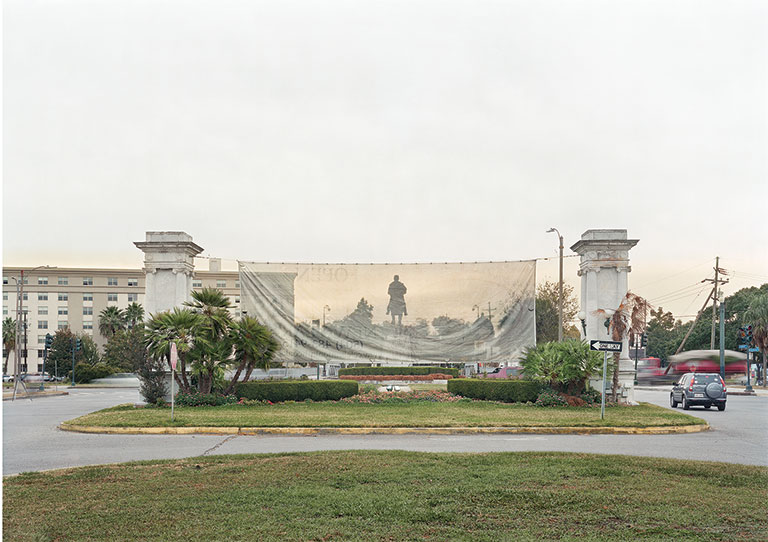
An-My Lê, Fragment I: General P. G. T. Beauregard Monument, New Orleans, 2016, inkjet print, 40 x 56.5 in. (101.6 x 143.5 cm); Courtesy the artist and Marian Goodman Gallery © 2020 An-My Lê
“There is a quietness to her photographs that is referencing the fact that the landscape remains. It’s a permanent witness to human activity.” – Dan Leers
The artist laughs when asked if she ever thinks of switching to a digital camera. “I think about it all the time,” she says. But she prefers the physicality of working with the manual camera and in the darkroom. “She works almost like a landscape painter,” Leers explains. “There is a quietness to her photographs that is referencing the fact that the landscape remains. It’s a permanent witness to human activity.”
Many of Lê’s photographs show landscapes being marred and blown up during training exercises. While Leers hopes that viewers first and foremost appreciate the beauty of Lê’s disarming images, he also hopes they ask questions such as, “What happens to the animals in a landscape when a bomb is dropped? What are the environmental factors implicated here?” He adds, “We play an active role in deciding who will send our brave men and women off to war. I hope everyone who sees this exhibition is encouraged to stop and think about the collateral impact of the decision we make at the polls.”
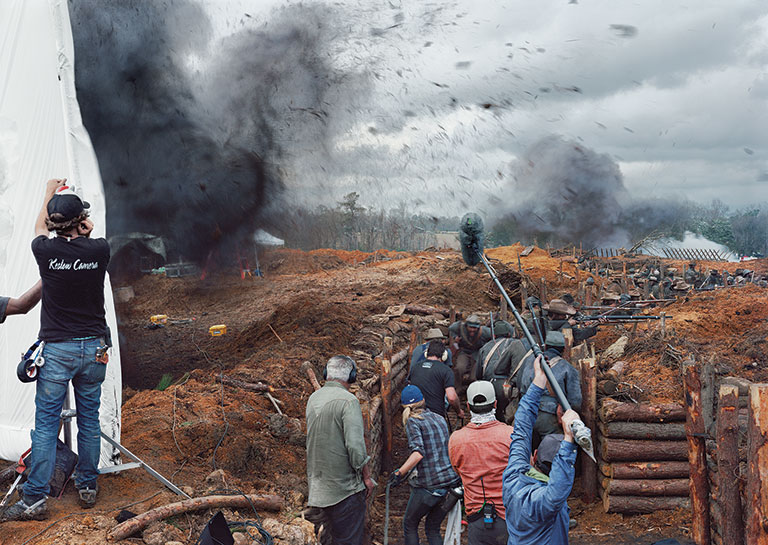
An-My Lê, Fragment I: Film Set (Free State of Jones), Battle of Corinth, Bush, Louisiana from the series Silent General, 2015, inkjet print, 40 x 56.5 in. (101.6 x 143.5 cm); Courtesy the artist, Marian Goodman Gallery, and STX films © 2020 An-My Lê
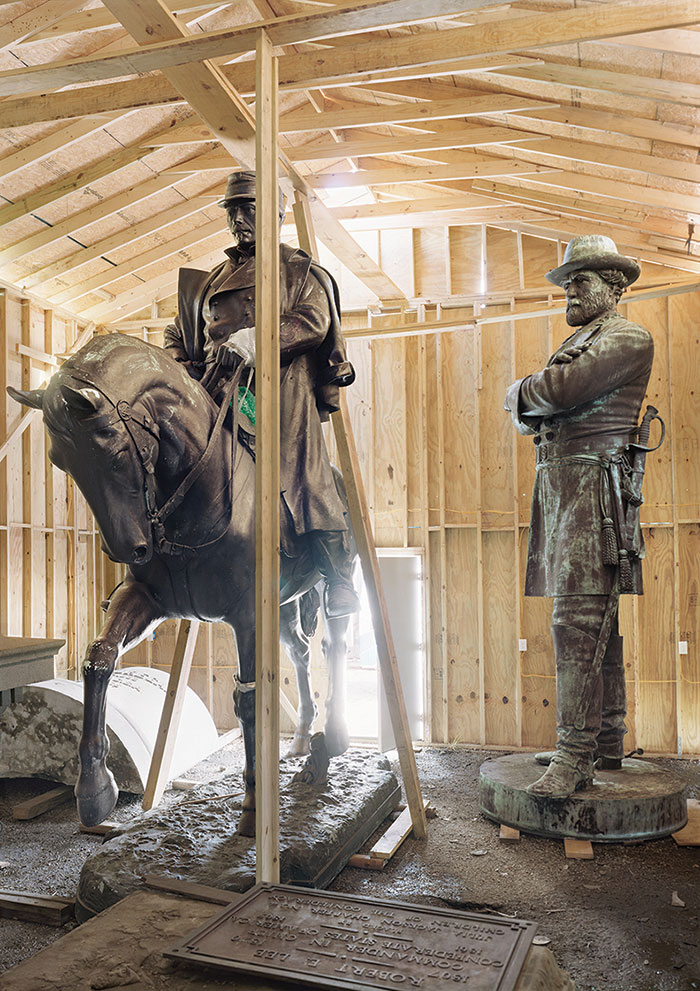
An-My Lê, Fragment VI: General Robert E. Lee and P. G. T. Beauregard Monuments, Homeland Security Storage, New Orleans from the series Silent General, 2017, inkjet print, 56.5 x 40 in. (143.5 x 101.6 cm); Courtesy the artist and Marian Goodman Gallery © 2020 An-My Lê
The most recent work in the show comes from a series that Lê still considers in progress. It’s titled Silent General after a reference to Ulysses S. Grant in Walt Whitman’s Specimen Days, an autobiographical account of his experience as a volunteer nurse during the Civil War. The series features photographs of Confederate monuments, but also of an empty Saturday Night Live set, young people protesting gun violence, and a U.S. Customs and Border Protection officer posing on a bridge. “Using persuasive color photographs, Lê complicates our understanding of how landscape has formed so much of the American identity,” says Leers.
Lê has always worked in well-defined series, but she says she’s ready for more freedom. “In this series, I gave myself the liberty to jump around in time or topics, tie things that may seem incongruous but make sense together,” she says. She thinks of her current work as an American road trip: “Whitman talks about the idea of the democratic landscape and I see that in these photos. They are a consideration of Americanness and a constant reminder that there are core values embedded in this country. It’s a consideration of hope for the future.”
Major support for An-My Lê: On Contested Terrain is provided by Lannan Foundation and the William Talbott Hillman Foundation. Additional support is generously provided by the Virginia Kaufman Fund, the Henry John Simonds Foundation, the Phillip and Edith Leonian Foundation, the E. Rhodes and Leona B. Carpenter Foundation, Jennifer and Karl Salatka, the Virginia S. Warner Foundation, and Deb and Sam Berkovitz.
Generous support for the exhibition catalogue has been provided by Marian Goodman Gallery.
Receive more stories in your email
Sign upTags:
Art
